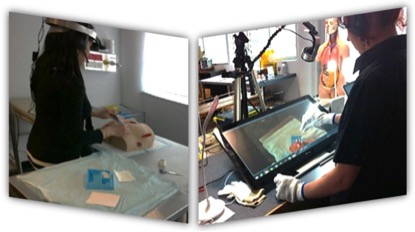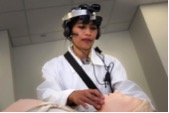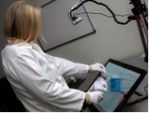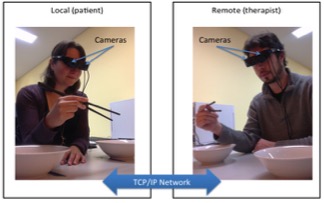An innovative tele-assistance system to support education in clinical procedures

Access to sound expertise and guidance to perform clinical procedures is often lacking, especially in more rural and isolated areas. In the absence of direct supervision, practitioners and students can feel underprepared and lack the skills and confidence to perform many procedures. This project aims to improve the situation by making remote expertise and guidance more accessible.
In this project, we will trial the application of cutting-edge technology, a “wearable tele-assistance system” that will allow novices to undertake procedures with real-time audio and visual guidance provided by a supervisor at a distant location. This technology enables the instructor’s “helping hands” to be visually projected onto site (a patient’s wound for example) and allow the novice to shadow the instructor’s movements throughout the procedure (if necessary) or allow the instructor to “step-in” should an incorrect action be initiated.
Helping Hands: an innovative tele-assistance system for clinical skill development
The safe and correct performance of clinical procedures is a critical component of the skill set required by health care professionals. The development of competence in this area requires practice and repetition to improve eye-hand coordination and dexterity. Students are taught clinical (practical) skills in a laboratory under direct supervision. This supervision is resource intensive and time-limited. A student may therefore feel underprepared and lack confidence when they are asked to undertake a procedure whilst on placement at a hospital (and on entering the workforce).
This project aims to improve this situation by making remote expertise and guidance more accessible through the application of innovative Augmented Reality technology and wearable devices. The key feature that makes this technology unique is that it supports unmediated remote gestures by augmenting the object of interest with “helping hands”. This makes the users feel like they were working side by side although they are physically distributed, thus improving user experience and task performance.


Evaluating Inhabiting Visual Augmentation in a Telerehabilitation Context

This project describes a pilot study using a prototype telerehabilitation system (Ghostman). Ghostman is a visual augmentation system designed to allow a therapist and patient to inhabit each other’s viewpoint in an augmented real-world environment. This allows the therapist to deliver instruction and observe performance through the patient’s point of view. In a pilot study, we investigated the efficacy of Ghostman by using it to teach participants to use chopsticks. Participants were randomized to a single training session, receiving either Ghostman or face-to-face instructions by the same skilled instructor. Learning was assessed by measuring retention of skills at 24-hours and 7-days post-instruction. As hypothesized, there were no differences in reduction of error or time to completion between participants using Ghostman compared to those receiving face-to-face instruction. These initial results are promising and warrant further investigation.
GhostMan
Prof. Tom Furness and Dr. Winyu Chinthammit received UTAS internal exploration grant to develop and demonstrate a proof-of-concept wherein a physical therapist or healthcare professional is able to inhabit the body of a patient remotely in order to deliver movement instructions and therapy to the patient.